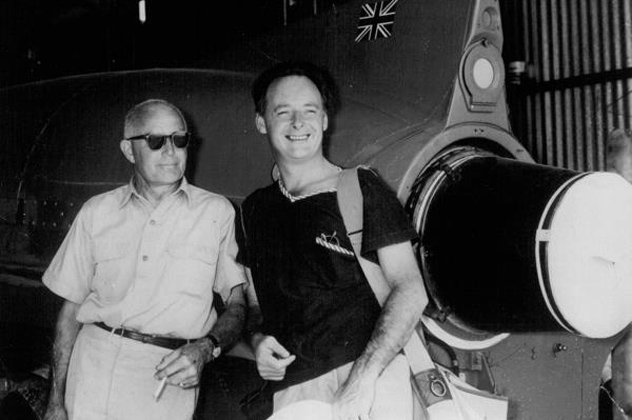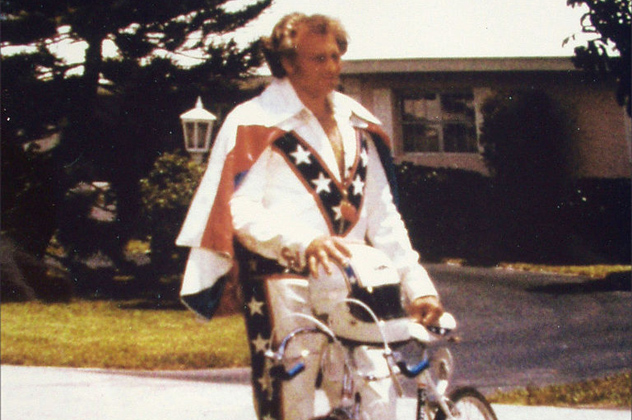 Movies and TV
Movies and TV  Movies and TV
Movies and TV  Humans
Humans 10 Times Scientists Were Absolutely Sure… and Absolutely Wrong
 Our World
Our World 10 Pivotal Moments for Life on Earth
 Movies and TV
Movies and TV 10 Most Realistic Medical TV Shows of All Time
 Creepy
Creepy 10 Eerie & Mysterious Ghosts of the Pacific Coast
 Weird Stuff
Weird Stuff 10 Typos That Accidentally Changed History
 History
History 10 Times Trickery Won Battles
 Technology
Technology 10 Awesome Upgrades to Common Household Items
 Misconceptions
Misconceptions 10 Hilarious (and Totally Wrong) Misconceptions About Childbirth
 Weird Stuff
Weird Stuff 10 Warning Labels That Exist Because Someone Actually Tried It
 Movies and TV
Movies and TV 10 Zombie Movies That Will Actually Terrify You
 Humans
Humans 10 Times Scientists Were Absolutely Sure… and Absolutely Wrong
 Our World
Our World 10 Pivotal Moments for Life on Earth
Who's Behind Listverse?

Jamie Frater
Head Editor
Jamie founded Listverse due to an insatiable desire to share fascinating, obscure, and bizarre facts. He has been a guest speaker on numerous national radio and television stations and is a five time published author.
More About Us Movies and TV
Movies and TV 10 Most Realistic Medical TV Shows of All Time
 Creepy
Creepy 10 Eerie & Mysterious Ghosts of the Pacific Coast
 Weird Stuff
Weird Stuff 10 Typos That Accidentally Changed History
 History
History 10 Times Trickery Won Battles
 Technology
Technology 10 Awesome Upgrades to Common Household Items
 Misconceptions
Misconceptions 10 Hilarious (and Totally Wrong) Misconceptions About Childbirth
 Weird Stuff
Weird Stuff 10 Warning Labels That Exist Because Someone Actually Tried It
10 Records Nobody Would Want To Break
Many of us dream of setting a world record. Who wouldn’t want to break the record for blowing the world’s biggest bubblegum bubble or owning the largest collection of traffic cones? But some record holders never planned or wanted the record they now hold, and few will seek to dethrone them.
10Farthest Distance Thrown By A Tornado And Survived

Matt Suter was a 19-year-old high school senior on March 12, 2006, when a storm rolled over his hometown of Fordland, Missouri. Suter was at his grandmother’s mobile home that Sunday night with grandma and a disabled uncle. As gusts of wind and rain pelted the trailer, Suter stood on a sofa and tried to close a window while dressed only in his boxer shorts.
That’s when Suter heard a roar. “It got louder and louder, like 10 military jets coming right at us,” he said. The mobile home’s front and back doors blew out and the walls, floor, and ceiling began moving “like Jell-O.” The trailer began to tip over and the walls began to collapse. Then a lamp hit Suter in the head, knocking him out cold. As his grandma watched, Suter’s limp body was sucked out into the maelstrom.
It was an F2 tornado and it carried Suter 398.37 meters (1,307 ft)—the length of four football fields. He awoke in a field, alive and unharmed except for a small scalp wound. Miraculously, his grandmother and uncle also survived the disintegration of their mobile home after being pinned to the ground by heavy furniture. Suter’s record-breaking flight is not without precedent. In 1999, an Oklahoma baby survived when a tornado threw her 30 meters (100 ft). A South Dakota girl and her pony were unharmed when a tornado flung them 300 meters (1,000 ft) in 1955.
Discover more incredible people and mind-boggling world records with Guinness World Records 2014 at Amazon.com!
9The Most Prolific Parents

We all shake our heads at the Duggars, the Arkansas family who have a reality show that documents how they survive 19 kids. But how would anyone survive 87 offspring? As unlikely as that number seems, Guinness World Records cites a contemporary newspaper account of Feodor Vassilyev, an 18th-century peasant from the Shuya District in Moscow. Feodor and two wives sired 22 sets of twins, 9 sets of triplets, and 4 sets of quadruplets.
Vassilyev was born around 1707 and began fathering rugrats at the age of 18. Forty years later, he stopped. He said that all but two of his children survived infancy, a remarkable number for that time. And by the time he was interviewed at the ripe age of 75, 84 of his kids were still living. His fecundity was so extraordinary that he was sent to St. Petersburg to meet Empress Catherine II.
And who was the most prolific mother? That would be Feodor’s first wife. No one seems to have bothered to discover her first name, which is a shame because she deserves far more accolades than her husband. She, after all, endured 27 pregnancies and 69 births. Feodor’s second wife—also unnamed—endured a paltry eight pregnancies and 18 births.
8The Heaviest Humans

It shouldn’t surprise anyone that the heaviest man and woman ever recorded were both Americans. Of all the countries, the US had the highest percentage—34 percent—of obesity in 2013.
Jon Brower Minnoch hailed from Washington state and at age 12 he weighed 135 kilograms (298 lb). His weight increased steadily until he reached a peak weight of 635 kilograms (1,400 lb) in 1978. That March, he suffered heart and respiratory failure and 12 firemen were needed to transport him to University Hospital in Seattle. Once there, he was diagnosed with massive edema and the doctor estimated that he carried 400 kilograms (900 lb) of accumulated fluid. He remained in the hospital for two years, lying on two beds lashed together. It required 13 people to roll him over.
While in the hospital, Minnoch married a woman named Jeannette and, because she weighed only 50 kilograms (110 lb), they set a record for the biggest weight difference between spouses. He was put on a 1,200 calorie diet and by the time he was discharged in 1980, he had lost 419 kilograms (924 lb), the largest weight loss ever recorded. But it took a toll on his body and he died in 1983 at the age of 41.
Guinness gives the nod for the heaviest woman to Floridian Rosalie Bradford, who reached a peak weight of 544 kilograms (1,200 lb). Like Minnoch, Bradford fought obesity all her life, but it wasn’t until she married and had a child that her weight skyrocketed. She became so depressed that she tried to commit suicide with painkillers, but her weight was so great that the pills merely made her sleep for days.
After being contacted by weight-loss guru Richard Simmons, she started a diet and exercise program. At first, exercise consisted of clapping her hands. In one year, she dropped 190 kilograms (420 lb) and eventually lost a total of 317 kilograms (699 lb), a record weight loss for a woman. In 1992, she weighed under 136 kilograms (300 lb) and went to school, earned a degree in psychology, and began touring the country delivering motivational speeches. She died in 2006 at the age of 63.
7The Most And Biggest Kidney Stones

By December 2009, 45-year-old Dhanraj Wadile, a shop owner in Shahadah, India, had endured six months of acute abdominal pain. Dr. Ashish Rawandale-Patil determined that Wadile suffered from kidney stones. Using an endoscope and a scalpel, Dr. Patil spent four hours removing 172,155 calcium oxalate and phosphate stones ranging in size from a millimeter to 2.5 centimeters (.039–.98 in). All of them came from Wadile’s left kidney.
It took Dr. Patil’s team over a month to count the stones. Once completed, he sent them all to Guinness to be verified. Sure enough, Guinness dubbed Wadile’s feat a world record, beating the previous record of 14,098 stones removed from one patient.
The lucky record holder for the largest stone was also from India, a 37-year-old Mumbai police constable named Vilas Ghuge. In February 2004, Ghuge had a stone surgically removed that was 13 centimeters (6 in) across. Typically, stones are no bigger than 9 centimeters (3.5 in) across, about the size of a baseball. There is also another contender: In 2009, a Hungarian named Sandor Sarkadi had a 1.13 kilogram (2.5 lb) stone removed that was the size of a coconut.
6Survived The Fastest Car Crash

Donald Campbell held eight world speed records, both on land (LSR) and the water (WSR). He is still the only person to break both the LSR and WSR in the same year (1964). But on September 16, 1960, he set one record he hadn’t counted on.
Donald was the only son of Sir Malcolm Campbell, a racing pioneer and holder of 13 speed records, nine on land and four on the water. Shortly after his father’s death, Donald heard that an American was attempting to break his dad’s WSR and decided that he needed to keep his family’s flag flying. During the 1950s, Campbell nudged the WSR steadily upward from 257 to 418 kilometers per hour (160–260 mph). He constantly measured his success against his father’s, frequently asking his best friend if he thought Sir Malcolm “would be proud.” And in 1960, young Campbell took on the LSR that had already dethroned his father’s record.
That record was 634 kilometers per hour (394 mph), set by fellow Brit John Cobb. Cobb too had been on the LSR/WSR treadmill and in 1952 he died trying to break Donald’s WSR. Donald was certain that his Bluebird CN7 could exceed 643 kilometers per hour (400 mph), and he was on his sixth test run on the Bonneville Salt Flats in Utah when he lost control traveling at 586 kilometers per hour (360 mph). The Bluebird’s structural strength saved his life that fateful day on September 16, 1960, but he did suffer a fractured skull and a ruptured eardrum.
Within months, he was racing again, but it wasn’t until 1964 that the Bluebird achieved a record 648.5 kilometers per hour (403 mph). He returned his sights to the water and died on January 4, 1967, when he lost control of his Bluebird K7 at more than 480 kilometers per hour (300 mph). His body remained at the bottom of the lake, Coniston Water, until it was recovered in 2001.
5Longest Time Spent On A Gurney In A Hospital Hallway

Guinness created a new category when Tony Collins, a 40-year-old Brit, reported that he had lain on a gurney for 77 hours and 30 minutes. Collins was a diabetic and caught a virus that sent him to Princess Margaret Hospital at Swindon, England on Saturday February 24, 2001. Told that he would have to wait for a hospital bed, he was put on a gurney in a hallway parked outside the bathroom at 3:00 PM. “I developed a bad back, had no privacy, and had to rely on the nurses to bring me a drink because there was nowhere to rest a jug,” he said. They finally found a room for him at 8:30 PM—on Tuesday.
Ironically, while Guinness was investigating Collins’s claims, he again fell ill and returned to Princess Margaret. This time, he was left on a gurney for 60 hours. As for his record, he said, “Unfortunately, it will probably be the sort of record that gets broken every day in the NHS.” He was referring to the National Health Service, Britain’s government-run, public-funded healthcare system.
Collins’s prediction came true—in March 2013, 62-year-old Herbert Edwards was admitted for a suspected heart attack to Great Western Hospital, also in Swindon. He waited for a room on a gurney for six days, a total of 144 hours. He, however, will not break Collins’s record because he was kept in a “designated area” instead of a hallway. In that same hospital, 41-year-old June Rogers waited 157 hours for a bed, 88 of them on a gurney. She will not break Collins’s record either, because her hours on a gurney were not consecutive.
4Most Hand Amputations From The Same Arm

Some records are unlikely to be repeated not only because nobody would want to break them, but because of the controversy the record holder generated. Clint Hallam’s three hand amputations is just such a record.
Hallam’s first amputation occurred in 1984 while he was incarcerated in Christchurch’s Rollston Prison for fraud in his native New Zealand. A circular saw cut off his right hand above the wrist. Surgeons reattached the limb, but it became infected and was amputated a second time in 1988.
Ten years later, Hallam was offered a chance to make medical history as the recipient of the first hand transplant. He was flown to Lyons, France and the hand of a deceased French motorcyclist was successfully grafted. Hallam later said that he hated his new hand from the start: “The donor hand was bigger than my hand, bald and pink. And my skin is olive-toned and with hair. It didn’t match.” While recuperating, Hallam fell for his French nurse and left his wife of 12 years and their children. “Marti [the nurse] is the only good thing the surgeons gave me,” he said. “Apart from her, I gained nothing.”
Hallam lost contact with his doctors and stopped taking his anti-rejection medication. Inevitably, his body rejected the hand and it had to be amputated a third time in 2001. The medical world and his French surgeon were bitter over the waste of the donor’s hand. Hallam asked for another transplant in 2002. To date, he has not received one.
3Most Bones Broken

By the time he jumped for the last time in 1977, Robert Craig Knievel, known as Evel Knievel, had logged 150 ramp-to-ramp motorcycle jumps over various obstacles. He crashed or had major mishaps during 18 of those jumps. As a result, he suffered more than 433 fractures of 35 different bones, a world record. He fractured his skull, nose, jaw, both collarbones, both arms, both wrists, his sternum, every single rib, and his back five times. In addition, he broke both ankles, some toes, his right shin, right knee, tailbone, left hip, and had his pelvis crushed and broken three times.
When his first serious injury occurred, he wasn’t even riding a motorcycle. In February 1966, Knievel tried to jump, spread-eagle, over a speeding motorcyclist. He jumped too late and was struck in the groin, tossing him 4.5 meters (15 ft) through the air. By far his worse crash was on December 31, 1967, when he tried to jump the fountains at Caesars Palace in Las Vegas, a distance of 43 meters (141 ft). He made it over the fountains but came up short on the landing, tumbled over the motorcycle’s handlebars, and skidded across a parking lot. His upper leg and pelvis were crushed and he fractured a hip, a wrist, both ankles, and received a concussion that put him in a coma for 29 days.
Retirement did not herald an end to hospital visits. A fall on a golf course resulted in a prosthetic hip. Knievel fell twice in his own whirlpool, breaking ribs and a knee. He received a liver transplant in 1999 after alcohol killed his own.
By the end of his life, he had a pump stapled to his abdomen that delivered morphine and synthetic heroin directly to his spine. He died on November 30, 2007, of pulmonary fibrosis.
Be a daredevil in your own driveway! Show off your skills on a Ten-Eighty Skateboard/BMX Launch Ramp at Amazon.com!
2Survived The Most Fatal Incidents In One Day

Dosha, a 10-month-old pit bull mix living with her master in Clearlake, California, had a really bad day on April 15, 2003. That morning, she jumped a fence to escape her yard and was subsequently hit by a pickup truck. Dosha was glassy-eyed and limp when the police arrived. Thinking that the dog was fatally wounded, the cop shot Dosha in the head, just below her right eye, to put her out of her misery. Animal control arrived and put what they thought was a carcass in a plastic bag. They transported Dosha back to the dog pound and loaded her into a freezer. Two hours later, a worker opened the freezer to find Dosha sitting up, still in the bag.
The officer’s bullet had traveled along Dosha’s skull—barely missing her brain—and had lodged in the skin under her jaw. She also suffered from hypothermia but had no broken bones from the initial accident. The bullet fragments were removed, but she was left with some hearing loss in her right ear. For her triple death-defying feat, Guinness dubbed Dosha the luckiest dog in the world.
1Hardest To Kill

Because they don’t want people competing for this record, Guinness doesn’t have an official category for this. But if they did, there would be a number of runner-ups. There’s the Russian mystic Grigori Rasputin who, in one frenzied night, was poisoned, shot three times, castrated, and dumped in a frozen river before he died. But the record-holder would undoubtedly be Michael Malloy.
Malloy was a 50-year-old Irish immigrant living in New York City in January 1933. He was formerly a fireman, but by then he was homeless and an alcoholic. Five acquaintances hatched a plan to take out three insurance policies on him, then murder him. One of the conspirators owned a speakeasy and gave Malloy an unlimited tab, hoping he’d drink himself to death. But even though Malloy spent nearly every waking moment exercising his elbow, he didn’t die.
Frustrated, the bartender, another conspirator, replaced Malloy’s whiskey with antifreeze. Malloy drank six shots of it before he passed out—but he didn’t die. For a full week, Malloy drank nothing but antifreeze. Next, it was straight turpentine. This was followed by horse liniment mixed with rat poison. When raw oysters marinated in wood alcohol failed to kill him, they tried spoiled sardines sprinkled with carpet tacks. Malloy came back for seconds.
One night, the temperature dropped to -25 degrees Celsius (-14 °F) and the conspirators dumped Malloy in a snow bank and poured water on his bare chest. When that didn’t work, another conspirator rammed Malloy with his taxi, sending the hapless man flying like a rag doll. The conspirator then drove over Malloy for good measure. That put Malloy in the hospital for three weeks, but he returned to the speakeasy, complaining, “I sure am dying for a drink.” Finally, they waited until Malloy passed out, stuck a rubber hose in his mouth, and fixed the other end to a gas outlet. It took an hour and Malloy’s face was purple, but he finally kicked the bucket.
The conspirators would have gotten away with it, but they squabbled over the insurance money loud enough for the police to get wind of the scheme. They were tried and four of the five conspirators were executed in the electric chair. All of them died on the first try.
Steve is a wannabe millionaire. You can help him with this by purchasing his book 366 Days in Abraham Lincoln’s Presidency: The Private, Political and Military Decisions of America’s Greatest President.








